2021 Yamaha Tricity 300
Yamaha Motor Australia have announced the release of the Tricity 300, the all-new 292 cc Leaning Multi Wheel (LMW) model that brings a fresh new look to the ever-growing Australian scooter market, at a ride away price of $11,849 in a Nimbus Grey colour scheme.
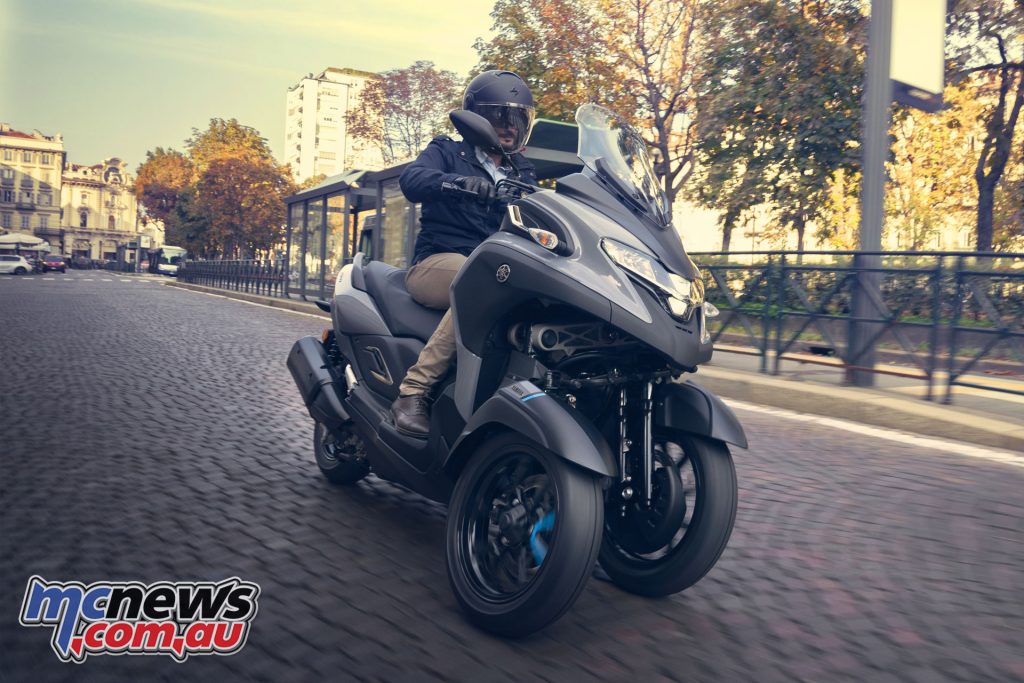
Tricity 300’s LMW technology and Stand Assist system is aimed at easing the transition from car to motorcycle for the large number of drivers currently looking for better transport solutions. Applying the in-depth LMW knowledge gained from the development and production of the Tricity 125/155 and Niken models, Yamaha designers created Tricity 300, offering more performance than the 125 and 155 models, without reaching the more performance and touring based specifications of the Niken.
Fitted with a model-specific Leaning Multi Wheel steering linkage, the Tricity 300’s leaning front wheels give a natural and confident cornering character and high levels of traction even on wet or slippery surfaces, with a turn and go throttle, ABS, unified brake system, traction control, large 14 inch wheels, generous storage and great economy, although weight is up over the XMax 300 with which is shares a powerplant, with the Tricity tipping the scales at 237 kg fully fueled.
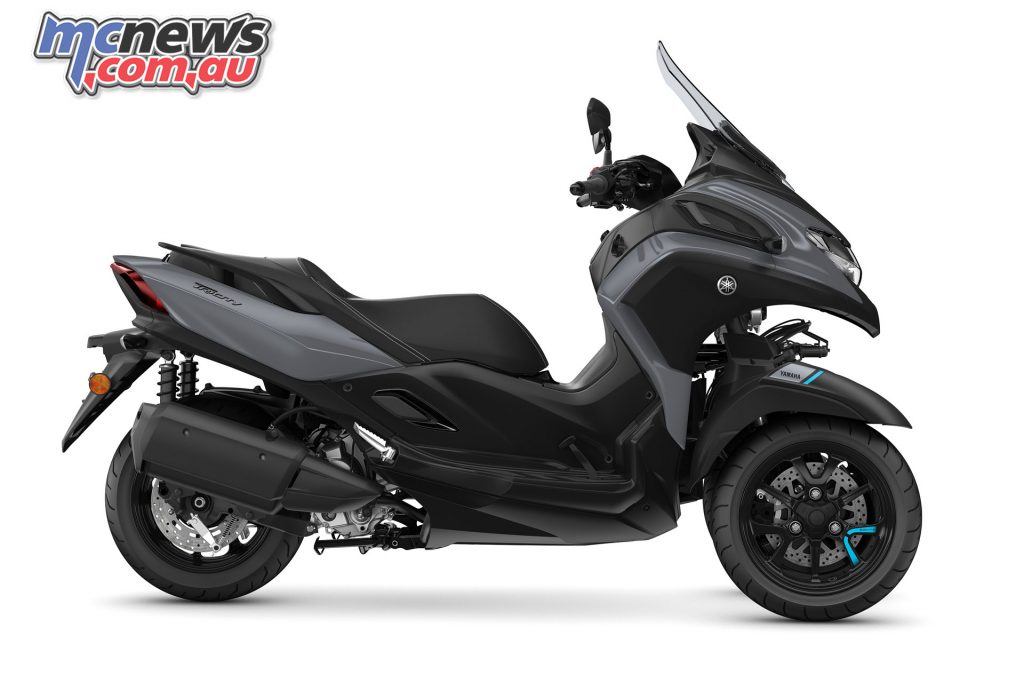
Tricity 300 features
- Yamaha-exclusive Leaning Multi-Wheel (LMW) technology
- Stand Assist tilt lock system
- Easy-to-ride design for new riders
- Economical Blue Core 300cc engine
- Traction Control System (TCS)
- Large brakes, ABS and Unified Braking System (UBS)
- Large 14-inch wheels
- Parking brake
- Spacious 43.5L of under seat storage
- LED lights and large LCD instruments
- Convenient Smart Key operation
- LMW Technology
Leaning Multi Wheel steering
The LMW steering mechanism contributes to the Tricity 300’s easy and user-friendly character by giving a generous 72 degrees of steering angle, making it easy to manoeuvre in congested traffic and tight spaces. Front-end traction and braking power are enhanced thanks to a wide 470mm front wheel-track, with a balanced and planted character when steering and cornering.
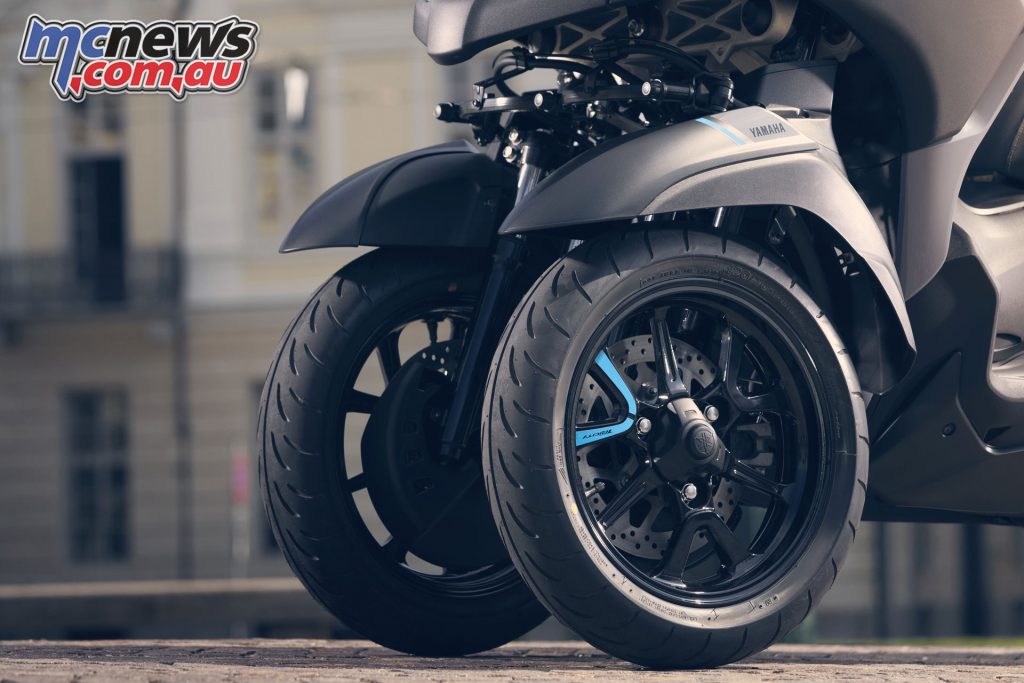
Standing Assist system
The Tricity 300’s Standing Assist system provides extra convenience by helping the machine to remain upright when stopped. This system features a caliper and disc mounted onto the LMW mechanism’s upper parallelogram arm. When the Standing Assist system is activated, the caliper’s compact electric actuator pushes the pads onto the disc locking the linkage in place.
As soon as the Tricity 300 throttle is opened the Standing Assist system disengages automatically, enabling the rider to ride away. The Standing Assist system also helps keep the bike upright at a standstill. The Tricity 300’s Standing Assist system is completely separated from the suspension functions, making it easier and more comfortable when manoeuvring it in tight spaces, as well as placing it on the main stand.
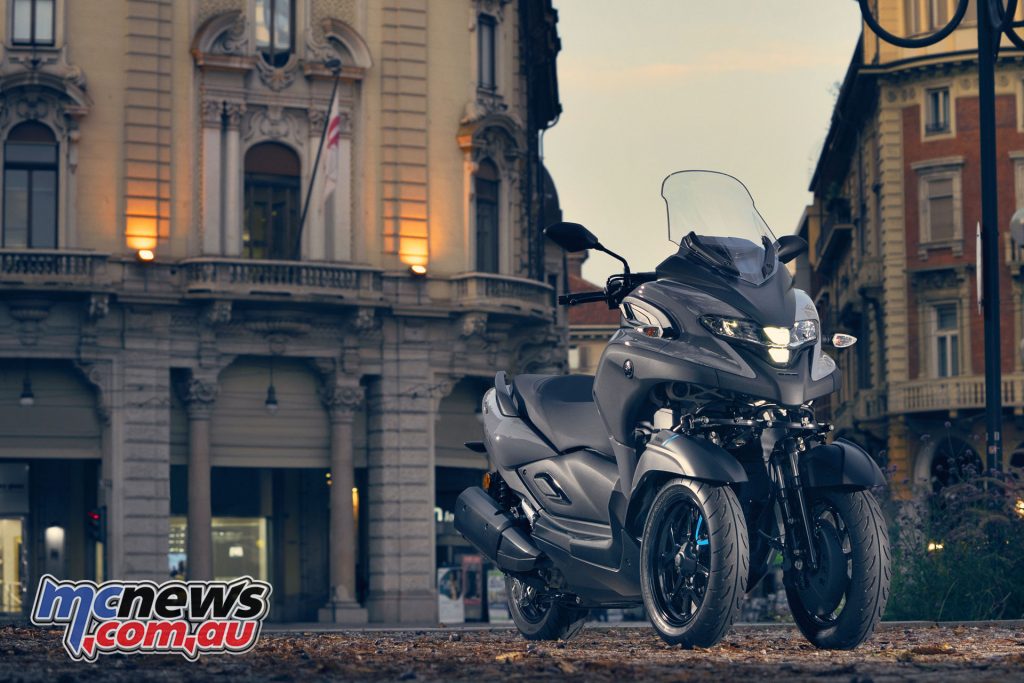
Tricity Style
The compact and aerodynamic front cowl is slim and high, with a short and relatively narrow nose that leaves an open space between the twin front wheels to emphasise the LMW design, and incorporates LED headlight, flashers, and tail light. The large 43.5L storage space under the seat has internal LED lighting and can accommodate two full-face helmets or one full-face helmet and an A4-sized briefcase.
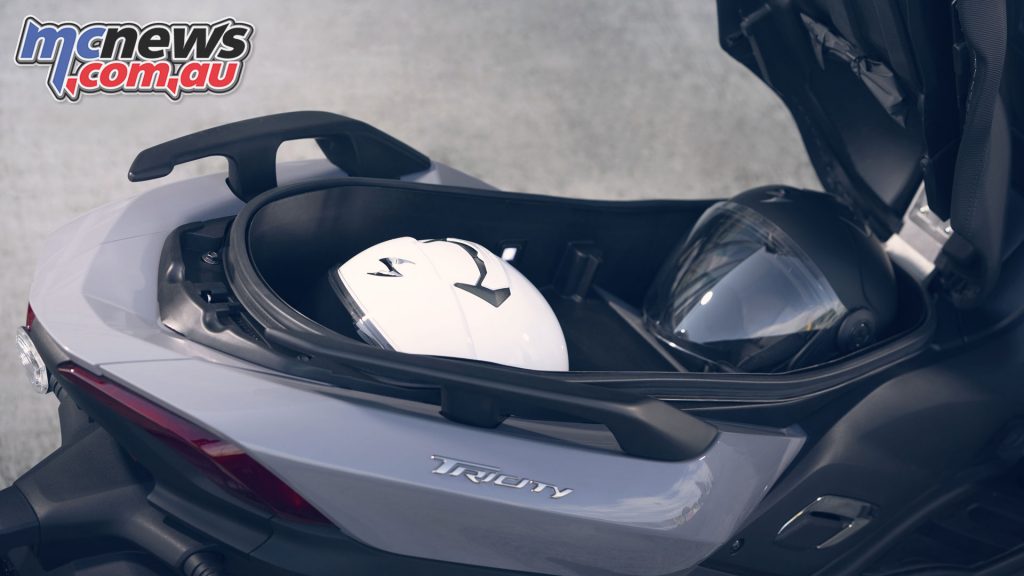
The LCD instruments have been designed to provide all the relevant information in a clear and easy to understand display. There’s a large digital speedometer as well as a bar-type tachometer, clock, odometer, and trip meters. The outer edges of the panel display indicator lighting for ABS, Standing Assist system, TCS, and ambient air temperature. A parking brake has also been fitted for ease of parking to secure the machine when not being ridden. There’s also a DC outlet port in the front panel for charging and powering various devices.
Blue Core 292 cc engine
An advanced Blue Core SOHC 292cc liquid-cooled four-stroke engine gives delivers a balance of strong performance with excellent economy, making the Tricity 300 ideal for longer distances and highway riding. When combined with the easy-going lightweight twist-and-go CVT automatic gearbox, the Tricity makes for an ideal commuter or getaway machine.
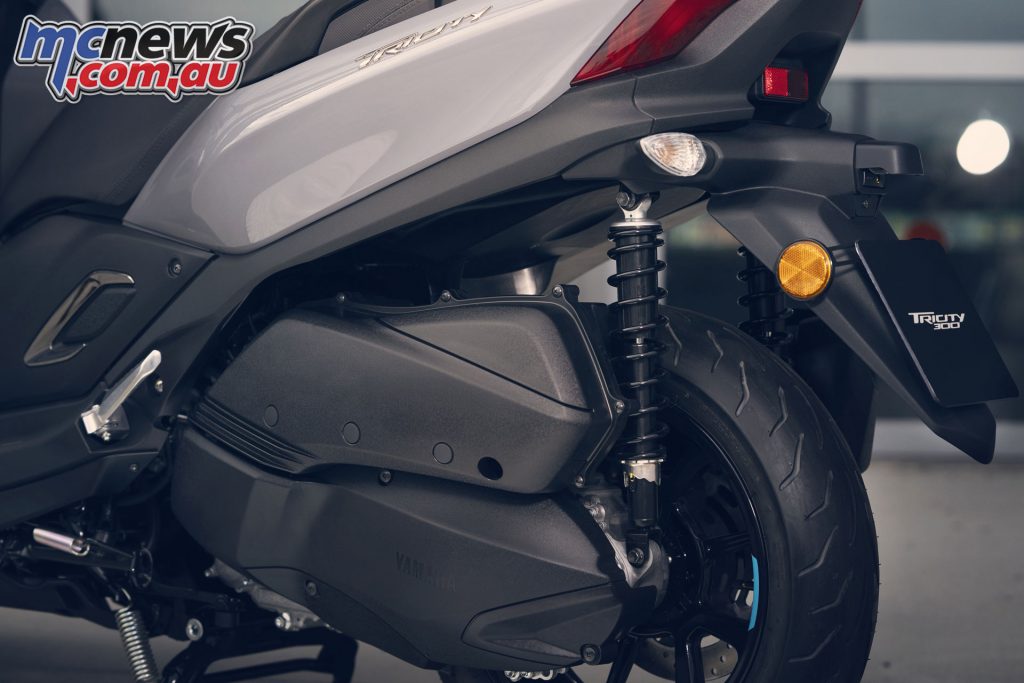
Chassis
To attract a new generation of riders, Yamaha’s designers have concentrated on creating a lightweight chassis that inspires confidence as well as exceptional agility. A 1590 mm wheelbase combined with optimised steering geometry, a 470mm front wheel track, and front-rear weight distribution of around 50:50 with a rider on board – ensure a great chassis balance and lightweight feeling. The engine is mounted to the new lightweight frame using a linked type system to minimise engine vibrations, delivering a silky-smooth ride. Fuel capacity is 13 litres.
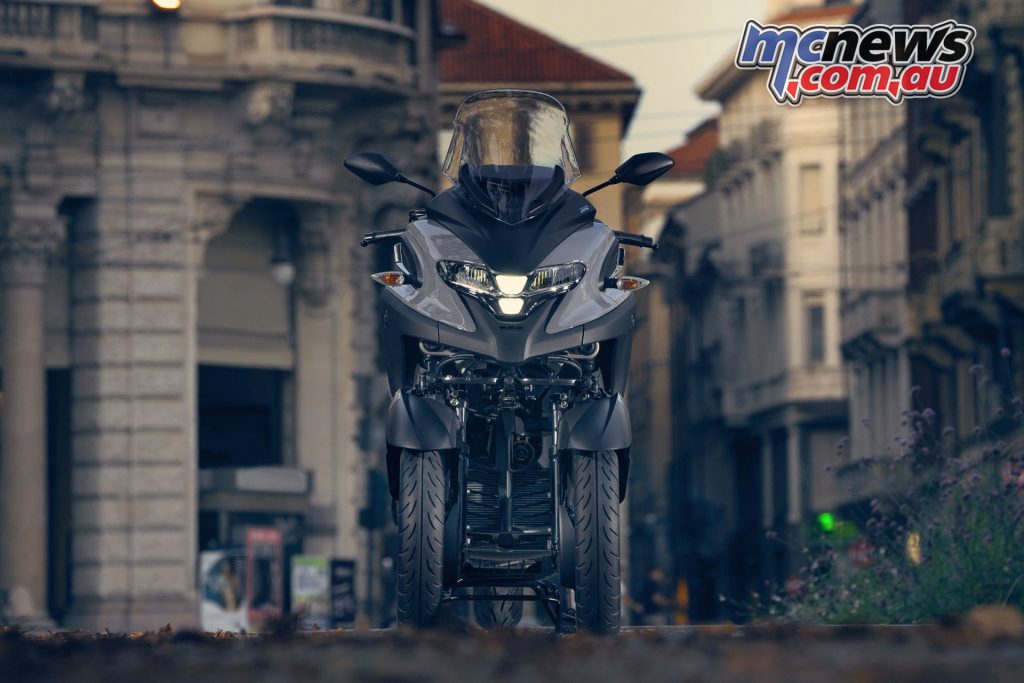
Wheels and tyres
Unlike many other three-wheelers in the 300cc+ class which feature smaller front wheels, the Tricity 300 has matching lightweight 14-inch cast aluminium wheels at the front and rear. New 14-inch tubeless tyres have been jointly developed with Bridgestone. The new tyres feature an optimised balance of stiffness together with a new compound designed to meet the specific requirements of the Tricity 300.
267 mm disc brakes
The use of 14-inch wheels has allowed the fitment of large-diameter 267mm discs on all three wheels to deliver exceptional braking power and control on a wide variety of road surfaces. As well as being equipped with ABS to prevent accidental wheel lock-ups on loose or slippery surfaces, the Tricity 300 also features Yamaha’s Unified Braking System (UBS) that balances braking force to all three wheels. When the rider applies only the rear brake braking force is applied to both the front and rear wheels.
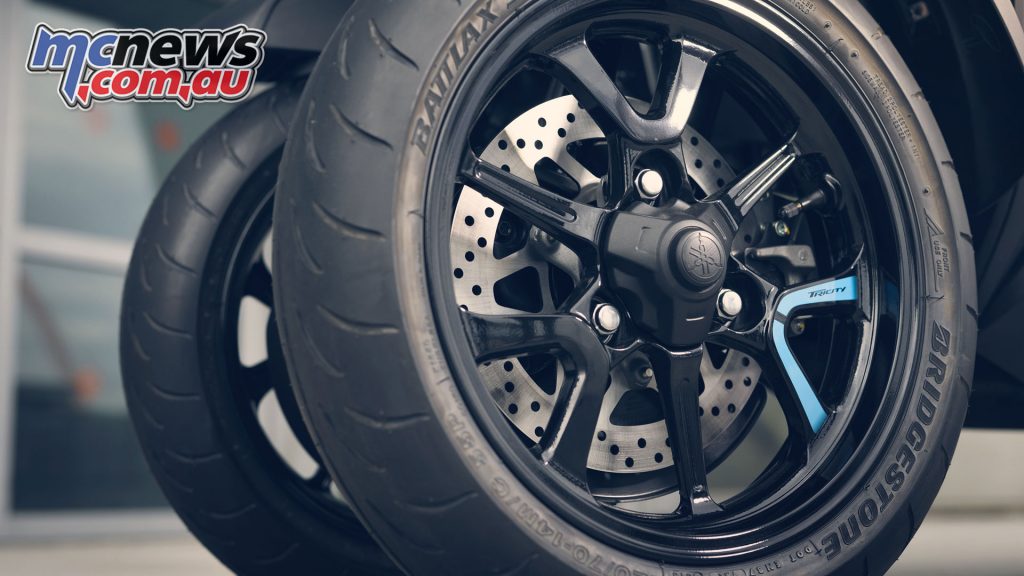
Safety, electronics & tech
Along with the three-wheel layout and the enhanced control offered by the ABS and a Unified Braking System, a Traction Control System (TCS) adds another layer of safety to the Tricity 300. The traction control can be deactivated via a dash-mounted button. Using the new Tricity 300 is also convenient thanks to its Smart Key system, allowing control of ignition and security functions without manually inserting a key.
The Tricity 300’s LCD instruments provide all the relevant information in a clear and easy to understand display. There’s a large digital speedometer as well as a bar-type tachometer, clock, odometer, trip meter and more. Indicator lights show ABS, Standing Assist system status, TCS, and ambient air temperature – with a warning light coming on at 3ºC and lower.
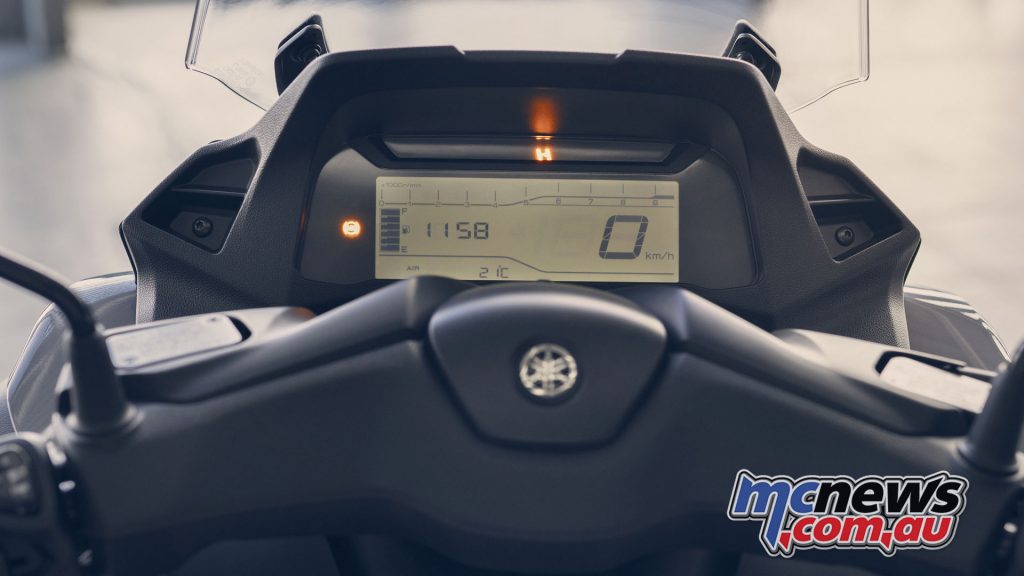
Contact your nearest Yamaha dealer to organise a test ride, or visit the Yamaha Motor Australia website for more information (link). The Tricity 300 is currently available for a ride away price of $11,849 inc GST* in the Nimbus Grey colour scheme. Finance and Insurance are also available through Yamaha Motor Finance.
*Pricing quoted is correct at time of publication on 28 Oct 2020.
| Yamaha Tricity 300 Specifications | |
| Engine type | Liquid-cooled, single-cylinder four-stroke, SOHC, 4-valves |
| Displacement | 292cc |
| Bore x stroke | 70.0 x 75.9mm |
| Compression ratio | 10.9 : 1 |
| Lubrication system | Wet sump |
| Clutch type | CVT |
| Ignition system | TCI |
| Starter system | Electric |
| Transmission system | Automatic CVT |
| Final Transmission | V-Belt |
| Front suspension | Double telescopic forks, 100mm travel |
| Rear suspension | Unit Swing, 84mm travel |
| Front brake | Hydraulic disc, 267mm – ABS |
| Rear brake | Hydraulic single disc, 267mm – ABS |
| Front tyre | 120/70-14M/C 55P Tubeless |
| Rear tyre | 140/70-14M/C 62P Tubeless |
| Overall length | 2250 mm |
| Overall width | 815 mm |
| Overall height | 1470 mm |
| Seat height | 795 mm |
| Wheel base | 1595 mm |
| Min. ground clearance | 130 mm |
| Wet weight | 237kg |
| Fuel tank capacity | 13L |






















